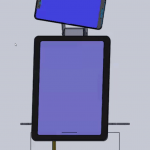February 5, 2021
Investigating cultural differences in the creepiness of social robots

EMAR Researcher Tanya Budhiraja is replicating Project EMAR’s U.S. Creepiness study in India! As with the previous study, teens in India discussed and explored where the line is drawn between helpful and creepy when it comes to social robots. In remote design sessions, teens in India created infinity diagrams and storyboards to define and…
January 13, 2021
Cross-country collaboration: building EMAR version 7 with expert robot designers

Last June, Project EMAR received the University of Washington’s Innovation Gap Fund grant from UW CoMotion to develop a robust prototype for Project EMAR. The team partnered with Guy Hoffman, an associate professor at Cornell University, and Roberto Aimi, an industrial mechatronics engineer and principal at Alium Labs. Guy and Roberto have worked together previously…
November 17, 2020
XR-EMAR: Moving EMAR into a virtual environment

In the last of Project EMAR’s three summer studies, the team developed and tested an online application called XR-EMAR where adolescents could interact with a 3D social robot prototype. Thanks to the customizability of XR-EMAR, teens created their own environments and EMAR robots. From placing EMAR in the middle of the ocean to adding animals…
October 28, 2020
COVID-MAR: Teens build their own at-home EMAR robots

Team EMAR embraced the circumstances of COVID-19 over the summer, determined to bring EMAR to teens even remotely. In the study of C-MAR (COVID-EMAR), teens connected with EMAR through a website on personal smartphones and used materials found at home to build their own little EMAR robot. Through lots of creativity and tripods, teens dressed…
October 21, 2020
Exploring creepiness in social robots
Project EMAR persevered this past quarantined summer, continuing the mission of building a social community-based robot for adolescents. In one of three projects, EMAR studied how teens may perceive a robot as creepy. “This theory is about how we want robots to be human-like, but if they become too human, we don’t like them at…
